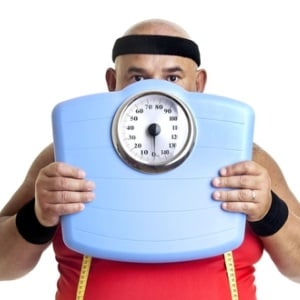
In the first part of our discussion of
methods to determining “fatness”, we considered the pros and cons of the BMI
(body mass index). Last week we discussed other techniques like the waist
circumference and the waist: hip ratio, as well as the new ABSI calculation and
the use of the Deurenberg equation (formula).
This week we investigate the accuracy of bioelectrical impedance analysis (BIA) for measuring percentage
body fat and predicting a patient’s risk of cardiovascular and other diseases of
lifestyle linked to obesity.
A popular
method
Bioelectrical impedance analysis is
particularly popular in fitness centres and gyms. Many distressed members of
the public have contacted me because their gym instructor put them on a machine
or scale that produced sky-high body fat percentage readings. “What must I do?
I only weigh 40kg (height 1.7m, BMI = 13,8 which is just about anorexic!) and
I’ve got a body fat percentage of 22%?” In this case it is clear that something
is not right at the gym: either the electrical bioimpedance analysis instrument
is not working properly or the person doing the readings is not interpreting
them properly!
What is
BIA?
According to Willett and co-workers (2006)
BIA or bioelectrical impedance analysis involves passing a weak current across
the extremities (hands and feet) to measure body composition. BIA is simple,
easy to use, and can in theory differentiate between fat mass and fat-free
mass. As mentioned before, measures like the BMI and WC and formulas based on
these measurements cannot differentiate between fat and muscle tissue in the
body.
Read: Body fat tied to heart risks in normal-weight adults
From a scientific point of view, most
devices used for BIA will measure the difference in impedance (the amount of
opposition an electrical current encounters when it passes through a liquid or
a solid) in the body quite efficiently. Lean muscle tissue has a lower
impedance than fat tissue. Equations or formulas programmed into the instrument
will use the readings to calculate fat mass or percentage body fat.
So although most people may find the
physics behind BIA difficult to understand, they probably like the idea of
stepping on a machine which calculates their body fat percentage in a flash.
Is BIA
reliable?
Willett and a team of co-workers at the Harvard School of Medicine (2006) carried out a large study to answer this question because they noticed that although most of the machines used to measure BIA are able to measure differences in impedance accurately, the calculations they carry out are still based on formulas that may not be 100 percent reliable.
Willett and co-workers (2006) used more
than 12,000 men and women who had taken part in the Third National Health and
Nutrition Examination Survey (NHANES III) conducted in the USA to compare
measurements of body fat obtained with BIA to results obtained with the
calculation of BMI. The researchers also compared how accurately the BIA and
the BMI are able to predict “disease or biological markers” (e.g. hypertension,
increased blood sugar levels, and raised blood cholesterol, and other fat
levels usually linked to obesity and other diseases of lifestyle).
Results of
the study
The results of this study showed that while the BMI consistently gave good results and predicted all the biological markers, the BIA results were not as accurate, no matter which formula was used to do the calculations.
The authors concluded that “the results
suggest that BIA is not superior to BMI as a predictor of overall adiposity
[body fatness] in a general population”, and that “BMI is a better, cheaper,
and easier measure of adiposity [body fatness] than BIA”. Other researchers
have also found that bioelectrical impedance measurements are not necessarily
more accurate than working out the BMI based on the height and weight of the individual.
In adolescents where the use of the BMI is not recommended, studies of the BIA
were also not satisfactory and tended to underestimate the body fat percentage of the
young subjects.
Read: High BMI bad for brain
These studies indicate that for the
general adult population, the relatively simple and inexpensive method of
working out the BMI can produce results which are equal to, or even better,
than the results of bioelectrical impedance analysis.
Body fat
in athletes
Many strength athletes may have BMI values
exceeding the upper value of the normal range of 25, because their bodies
contain such large volumes of muscle tissue. The most reliable method of
measuring body fat in highly trained athletes is to measure skinfold thickness
and compare the average of readings taken at 6 to 8 different places on the
body to various available scales like the “Oz-scale or O-scale”. Such
measurements and interpretations should be done by a trained expert like your
dietician or a biokineticist.
Body fat
in pregnancy and lactation
The weight and body fat of pregnant and
breastfeeding mothers should be assessed by their medical doctors or dieticians
and not by untrained staff. No pregnant mother should be told that she is “fat”
by anyone, particularly not by people who are not properly trained, because
weight loss programmes, intensive exercise regimens and the use of slimming
pills and potions during pregnancy can be dangerous to both the developing baby
and the mother. Moms who are gaining weight too quickly should be carefully monitored
by a registered dietician who will provide an eating plan which prevents
excessive weight gain, but still provides all the important nutrients that
mothers and babies need to develop normally and remain healthy.
Body fat
in children and teenagers
Adolescents and children should be assessed
for overweight and body fat percentage by a team consisting of a medical doctor
and a dietician. Considering that in 80% of cases overweight during adolescence
tends to carry on into adulthood and that overweight is generally linked to
diseases that cause death and disability, accurate measures of obesity in young
people are important. Skinfold measurements are generally the most accurate
method in everyday use when measuring overweight or obesity in youngsters.
Let your dietician or doctor do the
measurements and interpret the results for your child or teenager. The dietician
will also provide a diet for your child or teenager that will help the child
lose weight without depressing normal growth.
Conclusions
There are a variety of methods available to determine how fat someone is. The most accurate, but also expensive methods involve underwater weighing or dual energy X-ray absorptiometry (DEXA). These are however rarely used except in scientific studies.
Probably the most widely used methods are
calculating the BMI and measuring the waist circumference. The new ABSI
calculation also appears promising.
Read: Waist size = heart health
BIA or bioelectrical impedance analysis is
popular particularly at fitness clubs and gyms, but this method has its
shortcomings.
Measurements of skinfold thickness are recommended for special groups such as athletes, pregnant and breastfeeding women, children and adolescents.
If in doubt about your weight or body
fatness, go for an assessment by a registered dietician. Contact the
Association for Dietetics in SA (ADSA) at: www. adsa.org.za and click on “Find
a Dietician” to contact a dietician in your area.
Read more:
How accurate is the BMI?
Forget BMI, these are better ways to measure your body fat
BMI can predict heart disease
References:
- Burke L & Deakin V (2002). Clinical
Sports Nutrition, 2nd Ed., The McGraw-Hill Co, Australia
- Faria FR et al (2013). Body fat equations
and electrical bioimpedance values in prediction of cardiovascular risk factors
in eutrophic and overweight adolescents. International Journal of
Endocrinology, Vol 2013: Article ID 501638, 10 pages
- Trippo U et al (2004). Bioelectrical
impedance analysis for predicting body composition. American Journal of Clinical
Nutrition, 79(2):335-336
- Willett K et al (2006). Comparison of
bioelectrical impedance and BMI in predicting obesity-related medical conditions.
Obesity, 14(3):480-90.
Image: Fat man hiding behind scale from Shutterstock




 Publications
Publications
 Partners
Partners










